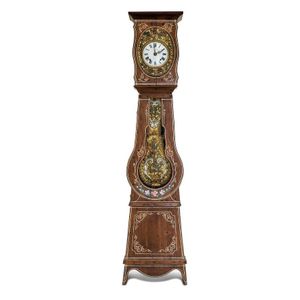Classical Revival Marble and Bronze Clock with Roman Scenes
You must be a subscriber, and be logged in to view price and dealer details.
Subscribe Now to view actual auction price for this item
When you subscribe, you have the option of setting the currency in which to display prices to $Au, $US, $NZ or Stg.
- Bronze - An alloy of copper and tin, traditionally in the proportions of about 9 parts of copper to 1 part of tin.
The discovery of bronze in Western Asia in the 4th century enabled people to create metal objects which were superior to those previoulsy possible because of its strength and hardness, and it has been used throughout the world for weapons, coins, tools, statuary and other decorative items.
It is very fluid in a molten state, and its hardness, strength when set, and non-corrosive properties makes it most suitable for casting sculpture. - Bas Relief - Bas relief, or low relief, is a carved surface in which the figures project from the background, but only to a limited extent. When a relief is cut in from a flat surface of stone or wood, the background or field is lowered, leaving the unsculpted parts seemingly raised. There are other degrees of relief carving, including high relief and mid relief.
- Pendulum - The pendulum was discovered around 1602 by Galileo Galilei, and was adopted for time keeping by the Dutch mathematician and natural philosopher, Christiaan Huygens, who excelled in astronomy, physics, and horology.
The pendulum comprises a metal rod usually of brass or steel with a metal disk, known as a bob, at the end. The movement of the pendulum is driven by weights or a spring, and as a pendulum swings in a regular arc, it was found accuracy could be controlled to within a few seconds a week.
Timekeeping can be adjusted by changing the height of the bob on the rod, making the pendulum either swing slower or faster.
The disadvantage of the pendulum was that changes in temperature also changed the length of the pendulum, interfering with the accuracy of the clock, and so in the 18th century two types of mercurial pendulums were invented which countered the movement in the steel rod.
The pendulum was the world's most accurate timekeeping technology until the invention of the quartz clock, regulated by a quartz crystal, in 1927.
This item has been included into following indexes:
-
clocks, type
- figural 695
- under glass dome 187
- Japy Freres / Japy & Cie (France) - clocks, maker or retailer 150
- meat covers / food covers / dish covers - pewter 1,562
Visually similar items

A late 19th century bronzed metal figured Ansonia mantel clock, the classical decorative baluster clock with enamel dial, Arabic numerals, exposed escapement, Ansonia details to the lower dial, flanked by a traditional French swordsman, all on ebonised pli

A French provincial comtoise longcase clock, 19th century, signed J. Denis, Vayres, 236 cm high, 49.5 cm wide, 21 cm deep

A French gilt metal cased mantel clock, mounted with Sevres-type porcelain panels and finial, the face bleu celeste glazed and with gilding, decorated with a landscape, the dial with Roman numerals, the case embellished with a floral urn pediment, foliate

A figural clock, 'Music', circa 1894, American, with maker's mark, Ansonia, to dial and mechanism, the bronzed spelter clock with an eight day movement and gong, the dial with a visible escapement, and an enamel dial with Arabic numerals set within a shape
